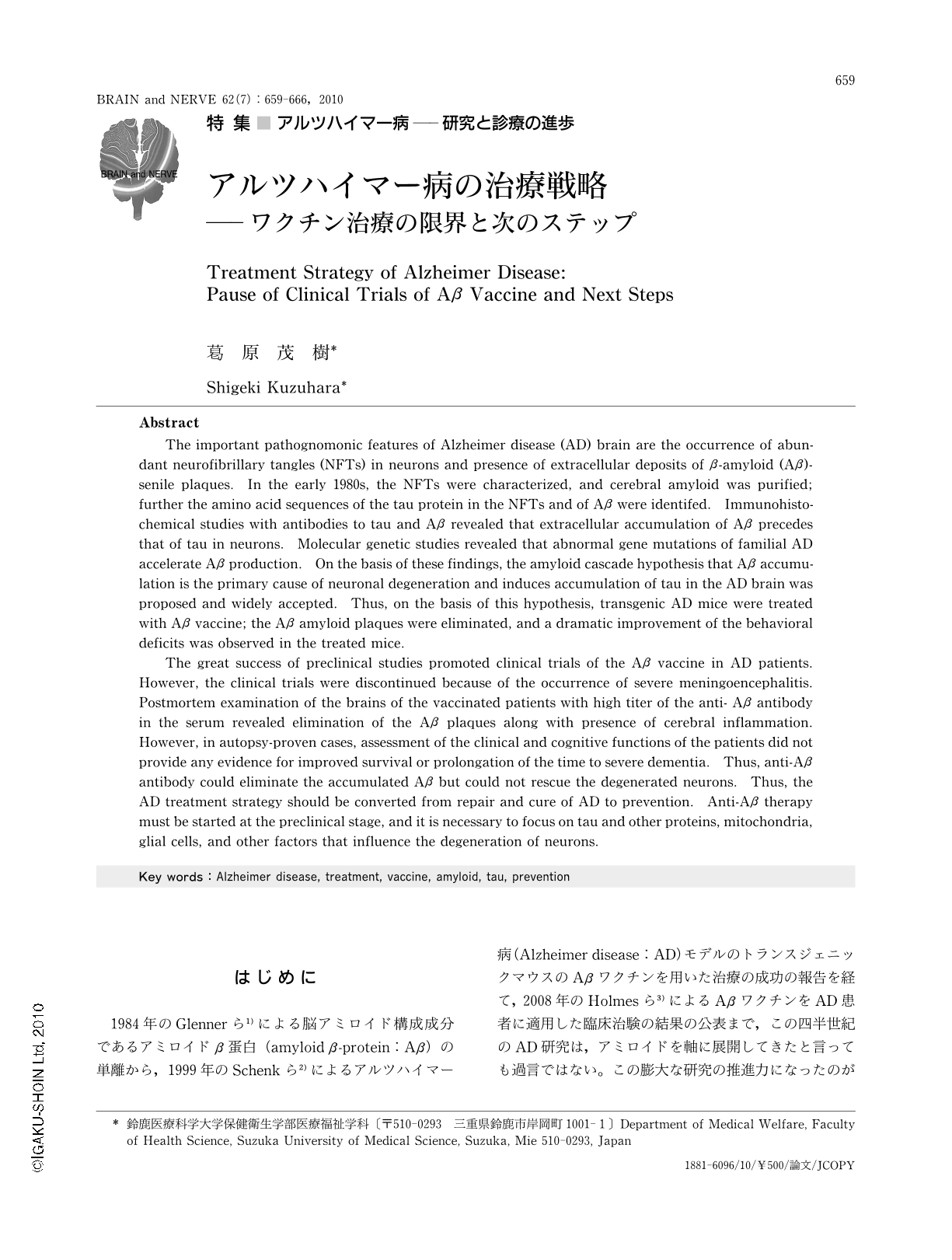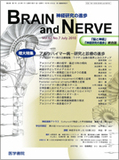Japanese
English
- 有料閲覧
- Abstract 文献概要
- 1ページ目 Look Inside
- 参考文献 Reference
はじめに
1984年のGlennerら1)による脳アミロイド構成成分であるアミロイドβ蛋白(amyloid β-protein:Aβ)の単離から,1999年のSchenkら2)によるアルツハイマー病(Alzheimer disease:AD)モデルのトランスジェニックマウスのAβワクチンを用いた治療の成功の報告を経て,2008年のHolmesら3)によるAβワクチンをAD患者に適用した臨床治験の結果の公表まで,この四半世紀のAD研究は,アミロイドを軸に展開してきたと言っても過言ではない。この膨大な研究の推進力になったのがアミロイド・カスケード仮説(amyloid cascade hypothesis:以下,アミロイド仮説)4,5)(Fig.1)であり,形態学,分子生物学,分子遺伝学がみごとにスクラムを組んで進められた。科学的仮説で得られた基礎研究の成果が比較的短期間にヒトへの病気の治療に応用されたという点では,translational medicineの成功例の代表格でもあった。
しかし結局,ヒトへの応用の臨床治験は,ワクチン接種後の髄膜脳炎発生のために中止になった6)。それに加え,その後6年間の追跡研究で得られた死亡後の剖検による診断確定例の検討では,脳組織からアミロイドは除去されていたにもかかわらず,臨床的に認知症の改善は得られなかった3)。このような現実を前にして,ADの治療戦略は根本的見直しを迫られることになった。この時点で,アミロイド仮説による研究の成果と限界を振り返ってみることは,次の治療戦略の構築のためにも意味のあることだと思われる。
Abstract
The important pathognomonic features of Alzheimer disease (AD) brain are the occurrence of abundant neurofibrillary tangles (NFTs) in neurons and presence of extracellular deposits of β-amyloid (Aβ)- senile plaques. In the early 1980s, the NFTs were characterized, and cerebral amyloid was purified; further the amino acid sequences of the tau protein in the NFTs and of Aβ were identifed. Immunohistochemical studies with antibodies to tau and Aβ revealed that extracellular accumulation of Aβ precedes that of tau in neurons. Molecular genetic studies revealed that abnormal gene mutations of familial AD accelerate Aβ production. On the basis of these findings, the amyloid cascade hypothesis that Aβ accumulation is the primary cause of neuronal degeneration and induces accumulation of tau in the AD brain was proposed and widely accepted. Thus, on the basis of this hypothesis, transgenic AD mice were treated with Aβ vaccine; the Aβ amyloid plaques were eliminated, and a dramatic improvement of the behavioral deficits was observed in the treated mice.
The great success of preclinical studies promoted clinical trials of the Aβ vaccine in AD patients. However, the clinical trials were discontinued because of the occurrence of severe meningoencephalitis. Postmortem examination of the brains of the vaccinated patients with high titer of the anti- Aβ antibody in the serum revealed elimination of the Aβ plaques along with presence of cerebral inflammation. However, in autopsy-proven cases, assessment of the clinical and cognitive functions of the patients did not provide any evidence for improved survival or prolongation of the time to severe dementia. Thus, anti-Aβ antibody could eliminate the accumulated Aβ but could not rescue the degenerated neurons. Thus, the AD treatment strategy should be converted from repair and cure of AD to prevention. Anti-Aβ therapy must be started at the preclinical stage, and it is necessary to focus on tau and other proteins, mitochondria, glial cells, and other factors that influence the degeneration of neurons.

Copyright © 2010, Igaku-Shoin Ltd. All rights reserved.


